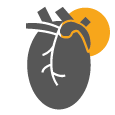
What is a rare disease ?
In the European Union, a disease is classified as “rare” if it affects less than 1 in 2000 people. While some rare diseases are quite close to a prevalence of 1 in 2000, most of them are actually much rarer, affecting only 1 in 100000, 1 in 1 million or even 1 in 1 billion people.
Over 6000 different rare diseases have been identified. Each month there are about 5 new rare diseases documented in medical journals.
About 5% of the global population live with a rare disease1. This means that 1 person in a group of 20 people is, or will be, affected by a rare disease at some point in their life.
In Luxembourg this represents some 30000 people and illustrates what could be termed “the rare disease paradox”: each individual disease is rare, but due to the high number of rare diseases the overall phenomenon is not rare at all.
Rare diseases are characterised by a wide diversity of symptoms. There are different subtypes for many of them, and even within the same disease symptoms can vary a lot. Rare diseases are often chronic and progressive, so symptoms can evolve over time.
Rare diseases can impact many body functions
Some key facts
72 percent of rare diseases are of genetic origin.
Other causes are bacterial or viral infections, allergies or environmental factors. For many other rare diseases, the origin is simply unknown.
70 percent of rare diseases start in childhood.
Even if symptoms do not appear immediately at birth, a genetic rare disease is generally present throughout the person’s entire life.
95 percent of rare diseases have no available treatment.
Many of which reduce the person’s life expectancy. Rare disease patients have to wait 5 years on average to receive a correct diagnosis, due to a lack of information, expertise and awareness.
List of rare diseases

For a complete inventory of diseases that are classified as “rare”, please refer to the Orphanet website – the European Portal for rare diseases and orphan drugs. This unique resource also provides directories of expert centres, clinical trials, registries, orphan drugs and many more.













